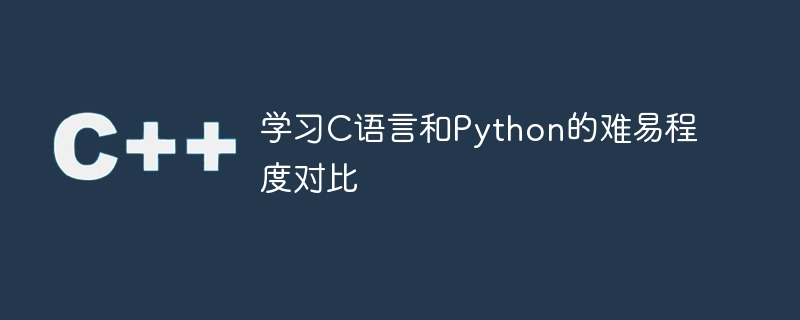Home >Backend Development >C++ >Comparison of the ease of learning C language and Python
Comparison of the ease of learning C language and Python
- PHPzOriginal
- 2024-03-18 16:18:031010browse

Comparison of the difficulty of learning C language and Python
C language and Python are two widely used programming languages, each with different characteristics and advantages. When learning these two languages, many people wonder how difficult they are. This article will compare the ease of learning C language and Python from different perspectives, and demonstrate the differences between them through specific code examples.
1. Comparison of syntax simplicity
Python is a high-level programming language known for its concise and elegant syntax. In comparison, the syntax of C language is relatively more cumbersome and complex. The following is a simple program that outputs "Hello, World!" to compare the syntax of the two:
Python sample code:
print("Hello, World!")C language sample code:
#include <stdio.h>
int main() {
printf("Hello, World!
");
return 0;
}As can be seen from this example, Python code is more concise and intuitive, while C language requires more grammatical structures. Therefore, Python may be easier for beginners to get started with.
2. Comparison of memory management
In C language, programmers need to manually manage memory, including memory allocation and release. Such a memory management method may lead to problems such as memory leaks. In contrast, Python has an automatic memory management mechanism, and developers do not need to pay too much attention to the details of memory management.
The following is an example of using dynamic memory allocation, comparing the differences between C language and Python:
C language sample code:
#include <stdio. h>
#include <stdlib.h>
int main() {
int *ptr = (int*)malloc(sizeof(int));
*ptr = 10;
printf("%d
", *ptr);
free(ptr);
return 0;
}Python example code:
ptr = 10 print(ptr)
As can be seen from this example, C language needs to use malloc and free functions to dynamically allocate and release memory, and Python is simpler in this regard.
3. Comparison of type systems
C language is a statically typed language, and the type of variables needs to be determined at compile time, while Python is a dynamically typed language, and the type of variables is determined at runtime. This makes Python more flexible, but also prone to causing some type-related errors.
The following takes variable type definition as an example to compare C language and Python:
C language sample code:
#include <stdio.h>
int main() {
int num = 10;
float price = 3.14;
char letter = 'A';
printf("%d %f %c
", num, price, letter);
return 0;
}Python sample code:
num = 10 price = 3.14 letter = 'A' print(num, price, letter)
This example shows that C language requires explicit declaration of types when defining variables, but Python does not.
Summary:
Learning C language and Python has its advantages and disadvantages, depending on personal learning habits and needs. C language is closer to the bottom and is helpful for understanding the underlying principles of computers and system programming; Python is more suitable for beginners to get started quickly and perform rapid prototype development. We hope that through the above comparison, readers can better choose a programming language that suits their learning and work needs.
The above is the detailed content of Comparison of the ease of learning C language and Python. For more information, please follow other related articles on the PHP Chinese website!
Related articles
See more- C++ compilation error: A header file is referenced multiple times, how to solve it?
- C++ compilation error: wrong function parameters, how to fix it?
- C++ error: The constructor must be declared in the public area, how to deal with it?
- Process management and thread synchronization in C++
- How to deal with data splitting problems in C++ development

